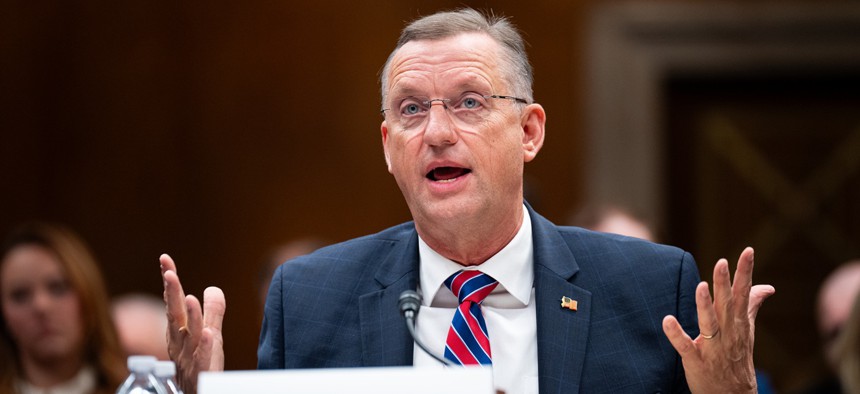Funding for further EHR deployments ‘vitally important,’ VA secretary says

Secretary of Veterans Affairs Doug Collins testifies during the Senate Appropriations Subcommittee on Military Construction, Veterans Affairs, and Related Agencies hearing on the FY2026 budget request for the Department of Veterans Affairs in the Dirksen Senate Office Building on Tuesday, June 24, 2025. Clark/CQ-Roll Call, Inc via Getty Images
VA Secretary Doug Collins said failing to modernize the agency’s electronic health record system “hurts our community care process because our doctors cannot communicate with the community [or] our doctors internally.”
Fully deploying the Department of Veterans Affairs’ new electronic health record system is necessary for streamlining veteran care and retaining clinicians, VA Secretary Doug Collins told members of the Senate Appropriations Subcommittee on Military Construction, Veterans Affairs and Related Agencies on Tuesday.
VA first signed a $10 billion contract — later revised to over $16 billion — with Cerner in May 2018 to modernize its legacy health record system and make it interoperable with the Pentagon’s new health record, which was also provided by Cerner. Oracle later acquired Cerner in 2022 and rebranded the new unit as Oracle Health.
Problems with VA’s EHR software arose, however, almost as soon as it was first rolled out in 2020 at the Mann-Grandstaff VA Medical Center in Spokane, Washington. Patient safety concerns, performance glitches and usability challenges plagued the system, leading to VA paused the modernization project in April 2023 until it could address problems at the sites where the software had been deployed. As of this month, the new EHR system has been implemented at just six of VA’s 170 medical centers.
VA announced in December that it was moving out of its operational pause and planned to roll out the new system at four Michigan-based medical sites in mid-2026. Collins subsequently announced in March that the department was planning to deploy the software at nine additional medical facilities next year, bringing the total to 13 sites.
During Tuesday’s hearing on VA’s fiscal year 2026 budget, Collins told lawmakers that VA’s continued use of its current EHR system — the Veterans Health Information Systems and Technology Architecture, or VistA — affects the retention of healthcare professionals across the agency’s operations. VistA runs on a programming language called MUMPS that some have argued is outdated.
“You're using a system that's costing us literally hundreds of millions of dollars, that's used nowhere else in the world except the VA,” Collins said, alluding to VistA. “So we need to move forward on this [modernization effort].”
He said VA has also worked to streamline engagement with their Oracle Health counterparts and to promote standardization across the sites using the new EHR software and added that “we had about a 10% gap to where VA would have our uniqueness [in coding].”
Sen. Gary Peters, D-Mich. — who noted that four of next year’s planned site rollouts are located in his state — called the EHR modernization project “a complex endeavor” and pressed Collins about how he would ensure that future software deployments are not beset by additional outages, slowdowns and disruptions.
“That's why the funding for this is so vitally important,” Collins said. “Because I can't emphasize enough, if we do not transform this system, it hurts our community care process because our doctors cannot communicate with the community [or] our doctors internally.”
The Trump administration’s FY26 budget proposal —released on May 2 — requests $3.5 billion overall for the deployment of the new EHR system, which represents a roughly $2.2 billion boost over the agency’s FY25 ask for the project.
Collins told lawmakers last month that he hopes successful rollouts of the system next year will lead to faster rollouts moving forward, with a goal of “probably the addition of 20 to 25 more” deployments at medical facilities in fiscal year 2027.
Last week, VA Deputy Secretary Paul Lawrence touted the progress the agency was already making ahead of next year’s planned rollouts and said deployment activities were already occurring at 11 of the 13 sites. He said VA was planning to begin activities at the two remaining facilities by the end of the month, and that the agency was hoping to fully implement the system at every VA medical facility by 2031.
Peters noted that surveys conducted during VA’s operational pause showed that efforts to right the modernization project were on track, with the number of system interruptions affecting clinicians decreasing, while veteran trust in the facilities where the system had been deployed was increasing. But he still expressed some concern about plans to restart deployments, given previous problems with the initiative.
“We do want to have more efficiency, but you have to make sure we don't have undue disruptions,” Peters cautioned.






